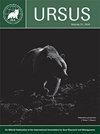Genetic status and conservation implications of endangered Formosan black bears
IF 0.8
4区 生物学
Q4 ZOOLOGY
引用次数: 0
Abstract
Abstract: The Formosan black bear (Ursus thibetanus formosanus, FBB) is an endangered subspecies of Asiatic black bear, geographically isolated in Taiwan from 6 other subspecies on the Asian continent and in Japan. Data on the genetic diversity and structure of wild FBB are lacking, though 2 potential hotspots for FBB occurrence have been identified; Yushan National Park (YNP) and Dasyueshan National Forest Recreation Area (DSY). Elucidating species' genetic structure can help assess the potential risks of population fragmentation and isolation that threaten FBB. Here, we employed 8 FBB-derived microsatellite loci to genotype 139 individuals from fecal samples collected in YNP, 20 captured individuals from both study areas, and 1 fecal sample from DSY, during 2009–2019. The marker set featured high polymorphic information content (mean > 0.699) and appropriate probability of identity (combined P(ID) < 0.0001) for individual identification. We detected high heterozygosity and no evidence of inbreeding in YNP, but the 2 subpopulations presented significant genetic differentiation. All DSY samples were assigned to one genetic cluster or phylogenetic clade, indicating that the DSY subpopulation is monophyletic. However, members of the YNP subpopulation were allocated to diverse lineages, and some YNP samples were partly assigned to the same cluster or clade as DSY individuals. We discuss potential evolutionary scenarios in which the observed population genetic structuring may have evolved. Based on our genetic results, the DSY and YNP subpopulations should be considered 2 separate management units and gene flow between both parts should be promoted.濒危台湾黑熊的遗传状况及保育意义
摘要:台湾黑熊(Ursus thibetanus formosanus, FBB)是亚洲黑熊的一种濒危亚种,在台湾与亚洲大陆和日本的6个亚种地理隔离。虽然确定了2个潜在的FBB发生热点,但关于野生FBB遗传多样性和结构的数据缺乏;玉山国家公园(YNP)和大岳山国家森林游乐区(DSY)。阐明物种的遗传结构有助于评估种群分裂和隔离的潜在风险,这些风险威胁到FBB。在这里,我们利用8个fbb衍生的微卫星位点对2009-2019年期间在YNP收集的粪便样本中的139个个体、在两个研究区捕获的20个个体以及在DSY收集的1个粪便样本进行了基因型分析。该标记集具有较高的多态性信息含量(平均值> 0.699)和适合个体识别的身份概率(组合P(ID) < 0.0001)。我们检测到YNP的高杂合性,没有近交的证据,但两个亚群存在显著的遗传分化。所有DSY样本都被分配到一个遗传集群或系统发育分支,表明DSY亚群是单系的。然而,YNP亚群的成员被分配到不同的谱系,一些YNP样本被部分分配到与DSY个体相同的聚类或进化枝。我们讨论了潜在的进化情景,其中观察到的群体遗传结构可能已经进化。根据我们的遗传结果,DSY和YNP亚群应被视为两个独立的管理单元,并促进两者之间的基因流动。
本文章由计算机程序翻译,如有差异,请以英文原文为准。
求助全文
约1分钟内获得全文
求助全文
来源期刊

Ursus
生物-动物学
CiteScore
2.00
自引率
15.40%
发文量
12
审稿时长
>12 weeks
期刊介绍:
Ursus includes a variety of articles on all aspects of bear management and research worldwide. Original manuscripts are welcome. In addition to manuscripts reporting original research, submissions may be based on thoughtful review and synthesis of previously-reported information, innovative philosophies and opinions, and public policy or legal aspects of wildlife conservation. Notes of general interest are also welcome. Invited manuscripts will be clearly identified, but will still be subject to peer review. All manuscripts must be in English. All manuscripts are peer-reviewed, and subject to rigorous editorial standards.
 求助内容:
求助内容: 应助结果提醒方式:
应助结果提醒方式:


